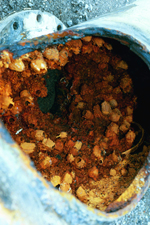





 |
Description - Blume Antifouling System?/font>
Marine growth, corrosion and scaling in sea water intakes, piping
and heat transfer surfaces, if uncontrolled, can result in increased
operating and maintenance costs. Fouled piping, valves, strainers and
heat exchangers cut down the cooling water flow resulting in
increased fuel consumption and, therefore, more frequent cleanouts.
In addition, these fouling sites can lead to accelerated corrosion,
which unchecked, results in eventual expensive equipment renewal.
The Blume Antifouling System incorporates the latest technology, the
use of impressed current sacrificial anodes for the protection of
the sea water service system in ships, drilling rigs, offshore
structures and coastal installations. The key elements of the system
are the copper and aluminum anodes employed.
The copper serves as the marine growth control agent, much like the
copper in hull antifouling paints. Copper released at
parts-per-billion (PPB) levels effectively inhibits the attachment
and growth of marine organisms such as algae, mussels, barnacles,
oysters, etc. Thus, by closely controlling the release of copper
into the sea water we are able to eliminate fouling by marine
organisms. Furthermore, maturing organisms have a threshold
tolerance to copper and by exceeding it we are usually able to
"force" them to exfoliate, thereby cleaning out an already fouled
system.
Aluminum, when released into sea water, forms a complex aluminum
hydroxide. Being alkaline, it serves as an effective neutralizing
agent, combining with the H+ (acid) ion in a corrosion cell, thereby
inhibiting further corrosion. Also, the aluminum hydroxide formed is
very gelatinous in nature. In a clean system it will deposit on the
surface and reduce the scaling tendencies which might otherwise lead
to scale buildup.
Iron (ferrous ion) will function similarly to the aluminum. In
applications involving copper-nickel alloys which we suspect may be
subject to impingement corrosion (e.g. Cu-Ni condensers on
steamships, in power plants, etc.) due to absence of sufficient
ferrous ion, we can utilize soft iron anodes effectively.
The Blume Antifouling System effectively combines these technologies
in sacrificial anodes capable of providing both marine growth and
corrosion control. Design life of the anodes is based on an analysis
of such parameters as flow rate, size of system(s) to be treated and
accessibility for anode renewal (system shutdown, ship drydocking
schedule, anode location, etc.). These factors dictate the size and
number of anodes and the current to be applied. |
|
